On the first day of February 2017, American music band Imagine dragons released a song titled Believer, a single which gained much appreciation over the music selling sites and video streaming sites, reaching top ten in many English speaking countries’ music billboard. The title of this post was culled from this awesome song. Speaking on the song, Dan Reynolds who co-wrote the song with other members of the music band stated:
"The meaning of the song is really reflecting on specific things in my life that were painful, whether it was anxiety and dealing with crowds, feeling overwhelmed by that or the success of the band, disease, going through depression—anything that was a source of pain in my life. And just rising above that, finding a place of perspective where I could be appreciative of the pain in my life and make it my greatest strength."
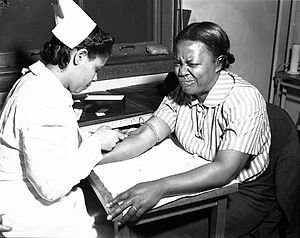
The feeling you can't hide! . Source:Wikimedia - CC BY-SA 3.0.Pain has become a very important part of our existence, and more of a daily experience than a ‘once in a while’ phenomenon, due to our challenging ecosystem, humans and other living things are rarely 100% healthy, hence we continuously feel mild to severe and at the extreme, unbearable pain which certifies one as unhealthy. However, pain is more of a psychological condition than a mere process of the nervous system. Our ability to deal with different amounts of pain in different ways makes it more of a constitutive than specific conditions. Different individuals have varying pain threshold and a resultant varied susceptibility to pain. On my recent posting to the phlebotomy unit, we had to take a 43years old man through special counseling processes before we could go ahead with blood collection for running his laboratory diagnosis, this is because he showed an alarming scare at the sight of the phlebotomy syringe and on our first attempt, a little prick of the needle made him scream noticeably, thus the much needed counselling was inevitable. Elsewhere and far from the phlebotomy unit, a nineteen (19) years old lady in the maternity unit pushed her baby out before the mid-wives could arrive, her delivery process was the easiest I’ve ever experienced. This is a perfect example of varied individual susceptibility to pain bearing in mind that labour pains is the highest physiological pain known, only few non-physiological pain can be compared to it, in the past, it was proposed to me equal to fracturing twenty bones and over the maximum pain any living being could take, this claim was proved wrong due to the concept of constitutiveness of pain.

Pain is the commonest signal of tissue or organ damage . Source:Wikimedia - CC BY-SA 3.0.
Pain to many may appear as an unnecessary discomfort, but if the development of human medicine should have a specific history, the roots wouldn’t be very far from **pain**, over 70% of patients seen in the hospitals complain of pain, which is thus the most popular symptom of any disease conditions, pain is a clear signal of tissue, organ or cell damage, and a prompt to take action towards arresting the condition and returning to normalcy, the concept of response to stimuli can only be possible if we could feel pain, which is the stimuli itself, in the absence of pain, damages to our body system can go on to a fatal level without being noticed. Morphine, the first used analgesic was named after *Morpheus*, the Greek god of dreams, without the feeling of pain, most deaths from diseases and infections will be more of going to sleep and dreaming than the present feeling of struggles and disturbances which surrounds sickness and physical accidents causing reasonable damages to the human body, while this feeling seems unnecessary, it is the clearest signal of unhealthiness and a prompt to seek medical attention. I guess the Imagine dragons gave the song a very rough texture to properly depict what pain means.
Pain may arise from any source, the feeling of pain through anatomical and physiological abnormality is only one out many ways through which one can encounter pain. Betrayal, disappointments and losing a dear one pains a lot, meanwhile, in these conditions, there were no physical damages, but still, a great deal of pain is felt, depression itself is a sort of pain even though it involves an uncommon feeling of calmness and deep thought, pain hence has many definitions, each one with a different message and addressing a given situation which is not general to the sources of pain, only relationship between these conditions beings a feeling of discomfort which generalises pain as a constitutive discomfort.

we feel ‘down’ and it pains! . Source:Wikimedia - CC BY-SA 3.0.
Being a psychological and physiological condition, the role played by the nervous system is central in our feelings not only of pain, but every other feelings which characterizes humans, while the depression of the amygdala brings a feeling of love and trust, the feeling of pain from different parts of our body follows a similar route as most other sensations in our bodies, *Receptors*; unarguably the most popular biochemical terminology, the concept of receptor have spanned over the aspect of human physiology to encompass the field of technology and the emulation of human receptors is the major basis of artificial intelligence, receptors defines living things, just as pain defines sickness and body damages. Receptors in biochemistry are macromolecules usually proteins which acts in response to the presence of a signal, which could be in the form of an ion or a ligand. Ligands generally speaking, are substances which can trigger the action of a receptor when they bind to it, this includes hormones, amines such as histamines, serotonin, bradykinin, and dopamine, putatitive neurotransmitters such as nitric oxides and other potent neurotransmitters such as Acetycholine, epinephrine and norepinephrine. Binding of these Ligands to their respective receptors stimulates the transmission of the information which these Ligands carry to the nervous system via the afferent system and the response to these stimuli which is coded by the central nervous system is relayed to the muscles, gland and other effectors. In fact, the action which the body is dependent on the ligand and the receptor which it binds to, a given ligand may cause totally different responses if it binds to different Ligands. This is the basis of most physiological responses and the action of these Ligands are enhanced or inhibited in the quest to address unhealthy conditions.
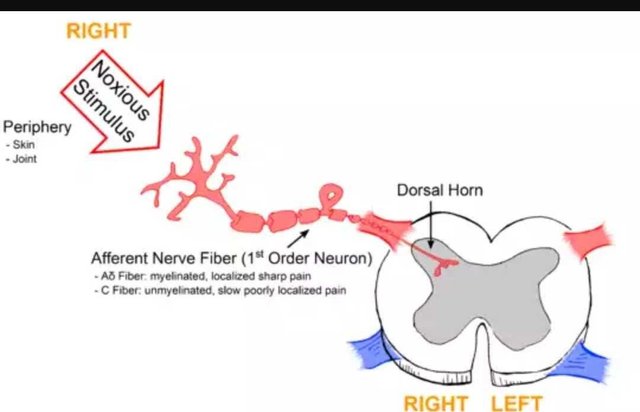
pathway of noxious stimuli . Source:Wikimedia - CC BY-SA 3.0.
Pain receptors are known as *nocioceptors*; they are found in almost every part of the body and sense noxious stimuli which are sent to the brain and spinal cord, they are sensory neurons with the cell bodies of the neurons which relays the noxious stimuli from the face located in the trigeminal ganglia; the dorsal root ganglia are associated with the neurons relaying stimuli from other parts of the body , axons of these neurons extend to the peripheral nervous system through which their signals are sent to the central nervous system, the brain and the spinal cord at different speed depending on the axon through which it is transported. A-fibre axons are myelinated and can transport action potentials at a speed of about 19metres/second while the C-fibre axons are unmyelinated and transport action potentials at a speed of about 2metres/seconds. Hence pain is felt at different speeds. Pain conducted via the A-fibres are felt as an acute intense pain which subsides with time, while pain conducted via the C-fibres are more prolonged. Nocioceptors can detect unhealthy changes in temperature (thermal Nocioceptors ), harmful chemicals (chemical Nocioceptors) and excess pressure or mechanical deformations (mechanical Nocioceptors). Polymodal Nocioceptors conducts more than one signal. Noxious signals activates the Nocioceptors which conveys the signals up to the spinal cord, within the dorsal horn of the spinal cord, the signals are transported through synapses with the aid of neurotransmitters to the brain.
In the brain, these signals are passed to the thalamus where different noxious signals are sorted and sent to different parts of the brain; physical sensations are sent to the *somatosensory cortex*, signals linked to emotions are sent to the *limbic system* while the *frontal cortex* receives signals in charge of thinking, the Nocioceptors hence conveys noxious signals emanating from physical body damages and other psychological abnormal conditions.
Analgesics, anesthetics and Anxiolytics:Superhumans in view?
“Taking a pill, now I am feeling better”, this is the phrase that comes to my mind from American trap musician Lil Pump’s 2018 single titled Drug addicts. Which clearly how good drug abusers feels on taking these drugs which they abuse. Pain killers are the most abused drug worldwide, as people in the quest to get rid of noxious feelings resort to these drugs and consume them in excess concentration to enable rapid restoration of the body conditions. Morphine the first every used pain killer was named after the Greek god of dreams, Morpheus(already stated), this is due to the feeling of calmness which one feels on consuming these substances, the absence of noxious signals means complete serenity in both internal and external body system, hence one feels an extraordinary calmness which gives a feeling of euphoria and a pleasure which keeps one coming back for them. Apart from these feelings, in ability to feel pains is a major characteristics of Superhumans, even in DC and Marvel superhero comics, these Superhumans has a special ability of pain tolerance and very high pain threshold, their Nocioceptors are manipulated and endowed with an envious ability to handle great amount of pain.
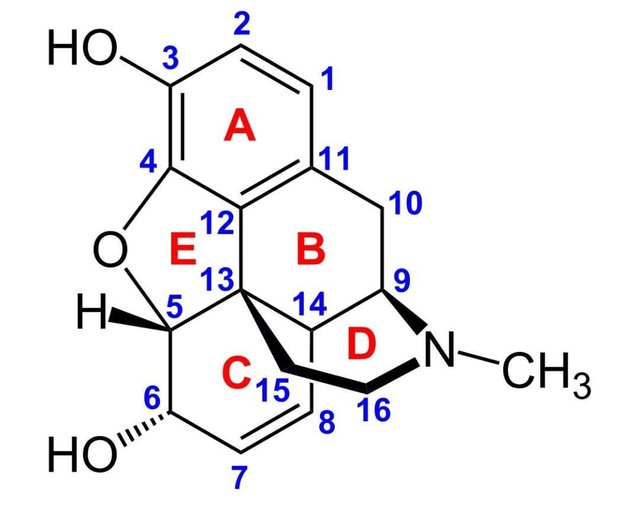
structure of morphine . Source:Wikimedia - CC BY-SA 3.0.
Analgesics are drugs that relieve pain by acting at some points in pain signaling mechanisms. Analgesics treat psychological and emotional factors as well, they may be centrally acting(narcotic/opioid) or peripherally acting( non-narcotic) . Centrally acting analgesics have a morphine-like activity and acts by releasing substance P in the central and peripheral nerves which reduces the feeling of pain and produces sedation which decrease the feeling of emotional upset and brings serenity to the body system. Chemical modifications of natural narcotics; morphine and codeine has led to the production of more potent centrally acting analgesics, such as *fentanyl, Penazocine, methadone, and tramadol* to mention just a few, with fentanyl, a 4-phenylproprionamido piperidine derivative of morphine being the most potent analgesic, is over eighty (80) times as potent as morphine but with a shorter duration of action ranging from 1-2 hours. Due to its analgesic activity, it can be used for severe acute pain and as a primary anaesthetic for cardiovascular surgeries because it produces minimal cardiac depression, this drug just as other analgesics have found great medical application, but even though they are not sold over the counter, the abuse rate of these drugs are on the increase as *‘hardworkers’* and depressed people tend to endow on themselves, the attributes of super humanity—low susceptibility to pain and disturbing feelings. Non-narcotic analgesics such as non-steroidal anti-inflammatory drugs (NSAIDS), selective COX2 inhibitors (such as retecoxib), and acetaminophen (paracetamol), also posses antipyretic, anti-inflammatory and anti-platelet actions in addition to their analgesic effect. While analgesics are the proper term for pain killers and seems to encompass drugs that helps deal with anxiety, **anxiolytics* are the most proper term for drugs which helps in dealing with anxiety.
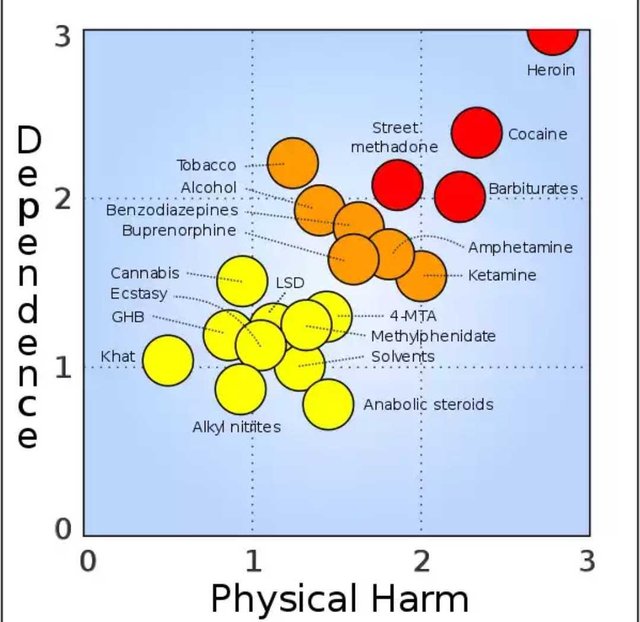
Pictorial graph of commonly abused substances and their dependence/harm ratio . Source:Wikimedia - CC BY-SA 3.0.
Anxiolytics are drugs used to relieve anxiety or used in management of anxiety disorder to induce calmness. Anxiety is an emotional state with subjective experience of fear unpleasant emotion with feeling of impending death, a feeling directed towards the future with impending feeling of death, a subjective bodily discomfort, anxious people tends to be too pessimistic as regards what tomorrow may be, this presents as autonomic hyperactivity, phobias, intense panic and obsession, this may be due to cardiovascular, endocrine, respiratory, neurological and metabolic disorders. Many drugs such as ephedrine, epinephrine, oxybutinin, bromocriptine, cocaine and pseudoephedrine when taken also induces anxiety, withdrawal from drugs such as barbiturates, benzodiazepans, alcohol and narcotics also causes a feeling anxiety for dependants/ addicts.
Analgesics, Anxiolytics and anaesthetics share a relationship in their mode of action, they antagonise the action of Nocioceptors by binding to their respective receptors, opioid analgesics binds to opioid receptors. Opioid analgesics agonize opioid receptors which are G-protein couple receptor (GPCR). This leads to events that ultimately block neuronal pain transmission by inhibition of activation of voltage-gated Ca2+ channels which depresses NT release, increases K+ conductance outside the cell to cause hyperpolarisation of cell thus reducing its excitability and inhibition of adenyl cyclase.
Opioid receptors have binding sites not only for endogenous opiates but also for opioid analgesics to relieve pain. Several types of opioid receptors includes, Mu, Kappa, Delta, Epsilon and Sigma.
u(mu) receptor- (subtypes 1 &2)
k (kappa) – (subtypes 1,2&3) and
Delta-( subtypes 1&2) are the main types of opioid receptors. Binding of these opioid drugs to these receptors leads to a reduced pain. The action of these agonists can also be blocked by opioid antagonists. These drugs block the effect of opioid agonists. These drugs are not analgesics and are used mainly to reverse the undesirable effects of the opioid agonists, they are:Naloxone,Nalmefene(longer duration of action than Naloxone( 8-10hrs). Is the newest of these agents and is a derivative of naltrexone. only given IV), Naltrexone( it decreases craving for alcohol in chronic alcoholics. Also facilitates abstinence from cigarette smoking and helps in weight reduction).
Analgesics, Anxiolytics and anaesthetics could usher in the era of Superhumans with awesome pain handling abilities as these compounds are constantly being improved to function with a greater potency and lesser side effects, many researches on possible enhancement of analgesics and Anxiolytics are ongoing while the cases of abuse is on the increase.
Is this a mere international dilemma, or a path to the era of ‘Superhumans’?. Your opinions are well welcomed
This is the second part of Everyday pharmacology series, check out the first part Here
References
pain and how you sense it
Nocioceptors~wikipedia
Pain~wikipedia
Believer~wikipedia
Katzung pharmacology, 5th edition.
If you write STEM (Science, Technology, Engineering, and Mathematics) related posts, consider joining #steemSTEM on steemit chat or discord here. If you are from Nigeria, you may want to include the #stemng tag in your post. You can visit this blog by @stemng for more details. You can also check this blog post by @steemstem here and this guidelines here for help on how to be a member of @steemstem. Please also check this blog post from @steemstem on proper use of images devoid of copyright issues here.





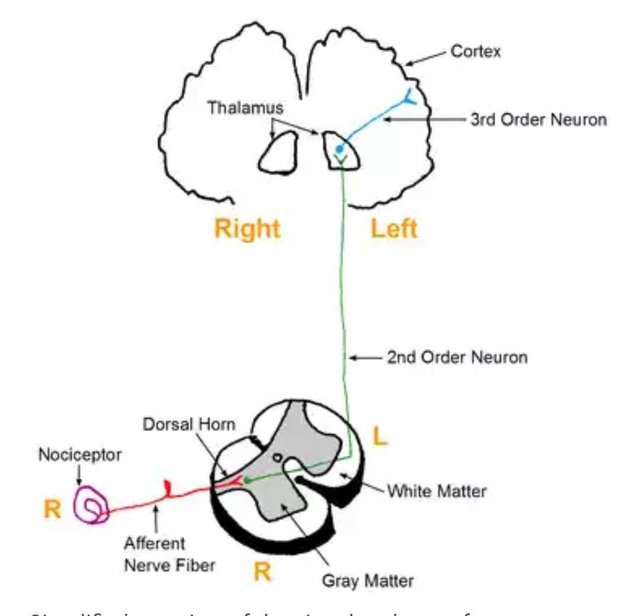



Hello! I find your post valuable for the wafrica community! Thanks for the great post! We encourage and support quality contents and projects from the West African region.
Do you have a suggestion, concern or want to appear as a guest author on WAfrica, join our discord server and discuss with a member of our curation team.
Don't forget to join us every Sunday by 20:30GMT for our Sunday WAFRO party on our discord channel. Thank you.
Painkillers are certainly abused as it is super easy to get some of them over the counter without doctor's prescription.
It's really an international issue, maybe that's a route to take us into the era of Superhumans.
Wow, that was quite long but kinda interesting. I have been meaning to ask, is itchiness a form of pain? They seem to be as a result of stimulation of different kind of receptors but sometimes overlapped.
Yes, itching is a form of pain, being a noxious feelings and being conducted through same path as other noxious signals via the Nocioceptors. But it appears to be a continuous inoculation of the Nocioceptors axons.
This post has been voted on by the steemstem curation team and voting trail.
There is more to SteemSTEM than just writing posts, check here for some more tips on being a community member. You can also join our discord here to get to know the rest of the community!
Hi @joelagbo!
Your post was upvoted by utopian.io in cooperation with steemstem - supporting knowledge, innovation and technological advancement on the Steem Blockchain.
Contribute to Open Source with utopian.io
Learn how to contribute on our website and join the new open source economy.
Want to chat? Join the Utopian Community on Discord https://discord.gg/h52nFrV